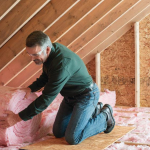Homeowners are always looking for ways to help protect their home foundations from unwanted water intrusion. If you have a concrete foundation and live in an area with heavy rain, flooding, or high snowmelt, you know how important it is to seal the exterior of your house as best you can. And if you don’t want the hefty expense of waterproofing your basement or crawlspace, keeping water away from the foundation is the best way to dry it. This blog post will show you how to protect your home foundation from water using some common sense tips and techniques.
Why Is There a Need to Protect the Home Foundation from Water?
Many homeowners don’t realize the damage water can cause to their homes. Following are some of the reasons why you need to protect your home foundation from water:
Water can cause the foundation to crack or bow: One of the most common problems caused by water is foundation damage. If your home is exposed to moisture, it can cause the foundation to crack or bow, and it can lead to severe structural.
Water can cause the foundation to settle: Another problem caused by water is foundation settlement. When the soil around the foundation gets saturated with water, it can cause the foundation to settle. It can also lead to severe structural problems.
Water can erode the soil around the foundation: Erosion is another problem caused by water. When the soil around the foundation is eroded, it can cause the foundation to become unstable, leading to problems with the structure of the home.
Water can cause mold and mildew: Mold and mildew can be a severe problem in a home, and they can cause respiratory problems and other health issues. They can also damage furniture, carpets, and other belongings.
Water can cause the home to become flooded: One of the worst things that can happen to a home is to become flooded. If the water level gets high enough, it can enter the home and cause extensive damage.
Water can erode the foundation materials and lead to structural failure: Another problem caused by water is corrosion of the foundation materials. When the foundation materials corrode, they can lose their strength and lead to structural failure.
How to Protect the Home Foundation from Water?
You can do several things to protect your home foundation from water. Some of the most effective methods include:
Check to See If Your Foundation Is Visible
Ensure a tiny gap between your home’s exterior materials and the foundation, even if an exposed foundation is not aesthetically pleasing. According to building and construction experts, at least 6 inches of brick or cement exterior foundations and 8 inches of wood foundations should be exposed. Moisture can easily permeate your foundation when soil, mulch, and other items are used to cover it.
Inspect Your Gutters and Downspouts
Another excellent technique to safeguard your foundation from water damage is to keep gutters and downspouts in good working order. Gutters can become clogged as a result of the collection of various debris.
To ensure that water runs smoothly, maintain them clear of any branches, leaves, or debris. A severe downpour will pour spilling water into the ground, near the foundation, if your roofing gutters are obstructed. On the other hand, your downspouts should drain a minimum of 10 feet from your house. You can lengthen downspouts if it isn’t enough to ensure that rainwater is channeled away from the foundation.
Your roof’s gutters and downspouts are integral in keeping water away from your foundation. Make sure that they are clean and free of debris so that they can adequately funnel rainwater away from your home. Also, ensure that the gutters are sloped correctly to flow in the right direction.
Install a Drainage System
Another great approach to protecting your property from water damage and minimizing the need for costly water damage restoration is to ensure that water is drained correctly out of your home. Make sure the dirt around your home is graded away from the foundation.
Installing French drain systems around the foundation is a second way to ensure proper drainage. For those who don’t know what it is, a French drain is a shallow drain that gathers and sends water away from your foundation.
To build this, dig a trench around your foundation, fill it with gravel, then attach a perforated drain. The trench should have a downslope of between 3% and 5% for a smooth water flow. Finally, make sure your basement has a functioning exterior drain. It could be in the shape of a footer drain or weeping tile that collects water in your basement and drains it.
Elevate Appliances and Furniture
When possible, try to elevate appliances and furniture in your home to avoid direct contact with the floor. If water does enter your home, it is less likely to damage these items if they are off the ground.
Maintain Your Property
Make an effort to keep your property well-maintained. It includes ensuring no water pooling on your property, leading to seepage and flooding. It is also essential to fix any cracks or holes in your foundation as soon as possible, as these can act as entry points for water.
Following are the tips on how to maintain your property in excellent condition:
- Look for cracks and deteriorated mortar joints in your home’s walls (pay special attention to the foundation walls). If you find any, take immediate and effective methods to correct the situation, such as restoring the mortar, sealing minor cracks using masonry caulk, and filling more significant gaps with hydraulic cement;
- Make sure there isn’t any water dripping down from the roof. Replace any broken tiles as soon as you spot them, as well as any loose or misplaced ones;
- Ensure your eavestrough system is in good working order by inspecting the gutters and downspouts for cracks, holes, or gaps every time you clean them and replacing any broken or rusted drainpipes as soon as possible.
- Inspect and maintain the plumbing system regularly;
- replace or repair broken or rusted pipes and valves, and protect them from the winter cold;
- Look for leaks under sinks, near toilets and bathtubs, and behind appliances, among other places. Look for black stains on floors, ceilings, or walls where pipes may be dripping, and fix any leaks you notice right away;
- Look for puddles of water around the foundation. After a rainstorm, remove any remaining puddles around the home and cover them with dirt to avoid pools from forming near the foundation in the future.
Make Use of a Sump Pump
Regardless of how hard you try to keep water out of your foundation, some events are beyond your control, such as overflowing rivers or natural disasters. If you find yourself in this situation, installing a good sump pump in your basement will help you avoid basement flooding and subsequent water damage to your foundation.
The working principle of a sump pump is simple. The pump has a sump basin that collects water from rain or seepage underground. If the water level rises over a certain level, the sump pump activates and drains the water into storm drains, dry wells, or sewage lines, depending on your municipality’s requirements.
Water damage can cause various problems for your home, from ruined furniture to extensive foundation damage. By following these simple tips, you can help protect your property from water damage and keep your home in good condition.
Conclusion
If you have a home foundation that has been exposed to water, it is essential to get the underlying source of the water leak fixed as soon as possible. Otherwise, your whole house could be at risk for mold and mildew growth, leading to structural issues. If these symptoms are left unchecked, they will worsen over time, making them more expensive or impossible to fix. You can take some precautions to help protect your home foundation from water damage in the meantime, but it is essential to address the water leak as soon as possible.









Leave a Reply